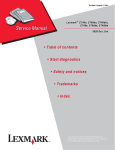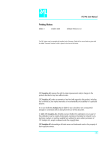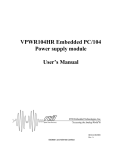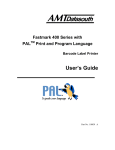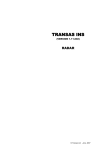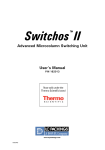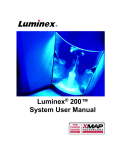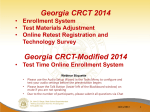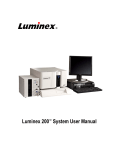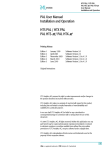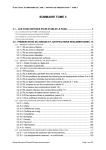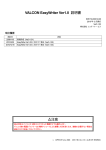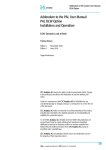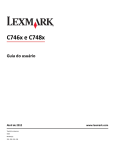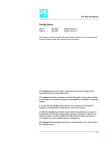Download Tips and Hints for PAL Systems including general technical HPLC
Transcript
SYSTEM Prep and Load Platform Tips and Hints for PAL Systems including general technical HPLC information 1. Valve Type and Characteristics 2. Valve Type, Bore Size versus Valve Volume 3. General Rules for Loop Filling 4. Low Volume Pick-up 5. Plumbing Diagram for the W-and Cheminert- Valve Types 7. Tubing Internal Diameter versus Flow Rate 8. Needle Guide and Needle Seals 9. Syringes and Needles 10. Microtiter / Deepwell Plates and the Piercing of Foils 11. Examples of Plumbing Diagrams for Micro/Nano Flow Applications 12. Carry-over | Troubleshooting 1. Valve Type and Characteristics Valve P/N No. of Ports Valve Type Inlet Port Valve Tube Bore Size Connect. in mm in inch Stator P/N Material Rotor P/N Material Flow Rate Range Remarks C2V-3006-CTC-K 6 C Vertical port 0.75 1/16 C2V-3C06 sst C2-30R6 Valcon H 5 to 100 mL/min Preparative application Bore size requires needle Gauge 19 Max. pressure 5000 psi/340 bar DC6WK-K 6 W Vertical port 0.40 1/16 na sst SSAC6W Valcon H 0.5 to 5.0 mL/min Valve for standard HPLC application. Column ID 4 mm, flow 1 mL/min Max. pressure 5000 psi/340 bar C2V-2346-CTC-K 6 C Vertical port 0.40 1/16 C2V-2C46 PAEK C2-23R6 Valcon E 0.5 to 5.0 mL/min Biocompatible Valve for standard HPLC flow rates Max. pressure 5000 psi/340 bar C2V-1006D-CTC-K 6 C Vertical port 0.25 1/16 C2V-1C06 sst C2-10R6 Valcon H 10 to 500 µL/min Valve for semi-micro columns ID 1 and 2 mm Max. pressure 5000 psi/340 bar C2V-1346D-CTC-K 6 C Vertical port 0.25 1/16 C2V-1C46 PAEK C2-13R6 Valcon E 10 to 500 µL/min Biocompatible Valve for semi-micro columns, ID 1 and 2 mm Max. pressure 5000 psi/340 bar C2V-0006D-CTC-K 6 C 0.15 1/16 C2V-0C06 sst C2-00R6 Valcon H 100 nL/min to 100 µL/min Injection Valve for micro columns Vertical port bore 0.25 mm, reduced to 0.15 mm at bottom Max. pressure 5000 psi/340 bar 0.15 1/16 C2V-0C46 PAEK C2-03R6 Valcon E 100 nL/min to 100 µL/min Biocompatible Injection Valve for micro columns. Vertical port bore 0.25 mm, reduced to 0.15 mm at bottom. Max. pressure 5000 psi/340 bar 6 0.10 C No vertical port 1/32 CN2-4C46I PAEK CN2-43R6 Valcon E 10 nL/min to 10 µL/min Biocompatible Valve for column switching only. Stator sst. wetted parts PAEK Vertical port C2V-0346D-CTC-K 6 C Vertical port CN2-4346D-CTC C72VX-1696D-CTC-K 6 C Vertical port 0.25 1/16 C72V-1C96 C72-16R6 N60C Valcon E3 10 to 500 µL/min Valve for ultra-high pressure use Max. pressure 15 000 psi/1030 bar C72VX-6696D-CTC-K 6 C Vertical port 0.15 1/16 C72V-6C96 C72-66R6 N60C Valcon E3 100 nL/min to 100 µL/min Valve for ultra high pressure use Max. pressure 15 000 psi/1030 bar PD7991 0.20 1/16 7991-005 Ti-plated with SPC-1 10 to 500 µL/min Valve for ultra high pressure use Vertical port bore 0.25 mm, reduced to 0.20 mm at bottom. Max. pressure 15 000 psi /1030 bar 6 R Vertical port 7991-999 PEEK blend RPC-10 Listing is not complete. Only most common valve types listed. Other configurations, such as 10-port or internal loop valves, are available. Key and Remarks to the Table “Valve Type and Characteristics”: P/N: “CTC”: Specific modifications for CTC Analytics AG. ”-K”: indicates a kit containing nuts, ferrules, Needle Guide, Needle Seals and Teflon waste tubing. Valve type: W-Type: Conical rotary valve, VICI/Valco. C = Cheminert-type : Flat plate rotary valve, VICI/Valco Plumbing for two different valve types is shown below. R = Rheodyne, flat plate rotary valve. Rotor material: Valcon H: Reinforced carbon fiber composite PTFE lubricated, inert engineered polymer. Standard material from VICI/Valco. Valcon E: Polyarylether ketone/Teflon (PAEK/Teflon) material if biocompatibility is required. Valcon T: Polyimide (Vespel)/PTFE/carbon composite. A choice when high temperature is required. Valcon E3: Wear resistant coating for UHPLC (proprietary, VICI/Valco). For material-specific information and limitations consult VICI/Valco product information bulletin. Bore Size: Valve connection port inlet/outlet path diameter. See graphic at right. Stator: sst = Stainless steel, N60 (corresponds to SS316) N60C Stator coated for UHPLC use. PAEK polymer related to well-known PEEK material. Rotor engraving 2 1 6 Bore size diameter 2. Valve Type, Bore Size versus Valve Volume Valve volume specification: Loop overfill (full loop): 2 ports and 1 engraving Partial loop filling: 1 port and 1 engraving. Sample loss at injection, Valve contribution (not overfill volume) Loop overfill (full loop): Content of 2 ports and 1 engraving Partial loop filling: Content of 1 port, engraving is injected. Valve Bore Size and Valve Type Volume for Port, Engraving Valve Volume for Partial Loop Valve Volume for Loop Overfill 0.75 mm Cheminert, sst Port: 1 2725 nL Other ports: 2725 nL Engraving: 1173 nL 6623 nL 3898 nL 0.40 mm W-Type, sst Port: 1 155 nL Other ports: 155 nL Engraving: 390 nL 545 nL 700 nL 0.40 mm Cheminert, sst Port: 1 615 nL Engraving: 170 nl Other ports: 220 nL 1005 nL 785 nL 0.40 mm Cheminert, PAEK Port: 1 650 nL Other ports: 345 nL Engraving: 170 nL 1165 nL 820 nL 0.25 mm Cheminert, sst Port: 1 320 nL Other ports: 75 nL Engraving: 70 nL 465 nL 390 nL 0.25 mm Cheminert, PAEK Port: 1 290 nL Other ports: 130 nL Engraving: 70 nL 490 nL 360 nL 0.15 mm Micro Cheminert, sst Port: 1 273 nL Other ports: 30 nL Engraving: 40 nL 343 nL 313 nL 0.15 mm Micro Cheminiert, PAEK Port: 1 514 nL Engraving: 40 nL Other ports: 40 nL 594 nL 554 nL 0.10 mm Nano Cheminert, PAEK Port: 1 8 nL Engraving: 13 nL Other ports: 8 nL 29 nL 21 nL All values are theoretical values. Values may change without notice and are provided by VICI/Valco. Rheodyne PD 7991: Port to port volume: 195 nL, 294 nL for vertical port (Port 1). 3. General Rules for Loop Filling Sample in Sample in Waste Waste Graphic A Sample Mobile phase Flow Full loop injection: Overfill Loop 3 to 5 times. Partial loop filling: Reliable working range: 20 to 60% of loop content. Example 1: Small loop size: Loop 20 µL. Volume needed to fill loop 60 to 100 µL. Example: Small loop size: Loop 20 µL. 4 to 12 µL sample volume. Example 2: Large loop size: Loop 200 µL. Use at least 300 µL to fill the loop Loops with larger volume can be filled within a range of 20 to max. 80% of loop content (200 µL or larger). Disregarding the rules will result in poor repeatability. The reason for these rules is the principle of hydrodynamic flow patterns in the solvent front reaching the loop inlet and outlet. See graphic A above. 20% 60% Reliable working range Injection speed: Example for a 20 µL loop: Injection speed is 5 to 10 µL/s. Higher speed will cause turbulence in the loop, resulting in poor repeatability. Injection speed is a PAL method parameter and must be adjusted for the type of solvent (viscosity and boiling point), loop size, or rather loop internal diameter, and the valve bore size. See the recommended method parameters listed in the PAL firmware software overview. 4. Low Volume Pick-up If a limited amount of sample solution is available, use of “low volume pick-up” mode is recommended. The sample solution is embedded in a solvent sandwich separated by small air gaps. The sample plug is positioned mid-loop. Important: Use a solvent with a lower elution power than the starting composition of the mobile phase gradient. solvent air sample air solvent A sample macro for the Cycle Composer software is available from any CTC Analytics representative. The macro is written with built-in flexibility to adapt to syringe, loop, and sample volumes. 5. Plumbing Diagram for the W-and Cheminert- Valve Types Sample in Sample in Sample in Vent/waste Sample loop 1 2 To column 3 5 Vent/waste 5 3 6 6 2 4 4 To column 1 Vent/waste Carrier/mobile phase Sample loop To column Sample loop Carrier/mobile phase Carrier/mobile phase VICI/Valco W-Type Valve Conical rotary valves (No biocompatible version available) VICI/Valco Cheminert Type Valve Flat plate rotary valve (Biocompatible version available) Rheodyne PD7991-K 15 000 psi /1030 bar Flat plate rotary valve Rheodyne Make-Before-Break® (MBB) technology features reduced pressure transients during valve actuation 6. Nuts and Ferrules Do not use a nut or a ferrule from a vendor other than specified for the product. While tightening the nut, keep tubing tightly positioned to ensure correct pilot distance. Do not over-tighten the nut / ferrule. Do not reuse an installed nut / ferrule for any other connection. Eliminate trapped air by installing nut / ferrule in wetted ports only. Tubing seats correctly at the bottom Disregarding these basic rules will lead to: Dead volume Peak deformation or peak splitting Carry-over effect Male nut (internal) Valco Parker Tubing doesn't reach the bottom, introducing dead volume Ferrule Rheodyne Tubing Pilot Tubing reaches the bottom before ferrule seats Swagelok 7. Tubing Internal Diameter versus Flow Rate The tubing internal diameter must be adjusted to flow rate, valve type, and application to avoid high backpressure or chromatographic irregularities. Tubing Internal Diameter versus Tubing Volume Examples are calculated for a tube length of 100 mm. Tubing ID Points to consider are: Delay volume of entire HPLC System Time needed for gradient to go active at column inlet Adjust tubing diameters and length: Solvent reservoir to pump: Cavitation? Pump head to mixing-T: Low backpressure Mixing-T to injection valve: Low backpressure; as short as possible Valve to column: ID as small as possible, considering backpressure Column to detector: ID as small as possible (if possible, smaller than # 4 considering backpressure) Tubing inch Tubing in mm 0.040 1.00 78.55 µL 0.020 0.50 19.64 µL 0.010 0.25 4.91 µL 0.005 0.13 1.33 µL 0.0025 0.064 0.32 µL Valve Type Bore Size in mm Flow Rate Range from – to Tubing ID inch / mm Tubing from – to # see diagram below 0.75 mm 5 to 100 mL/min Preparative application 0.25" / 6.35 mm 0.040" / 1.0 mm 1: Reservoir 2–5: Same ID for entire HPLC sytem plumbing to avoid backpressure 0.40 mm 0.5 to 5 mL/min Standard HPLC Column ID 4 mm 0.125" / 3.18 mm 0.020" / 0.50 mm 0.010" / 0.25 mm 1: Reservoir 2–3: Pump to Valve 4–5: Valve to Detector 0.25 mm 10 to 500 µL/min Standard HPLC Column ID 1 to 2 mm 0.040" / 1.0 mm 0.010" / 0.25 mm 0.005" / 0.13 mm 1: Reservoir 2–3: Pump to Valve 4–5: Valve to Detector 0.15 mm 100 nL to 100 µL/min Micro flow application 0.020" / 0.50 mm 0.020" / 0.50 mm 0.005" / 0.13 mm 0.005" / 0.13 mm 1: 2: 3: 4–5: 0.10 mm 10 nL to 10 µL/min Nano flow application Fused silica 50 µm 0.020" / 0.50 mm Fused silica 50 µm 3–5: Fused silica 25 µm 1: Reservoir 2: Pump Head to Mixing –T Mixing-T to Detector flow rates > 1 µL/min 3–5: Mixing-T to Detector flow rates < 1 µL/min Tubing volume Reservoir Pump Head to Mixing –T Mixing-T to Valve Valve to Detector Data for Tubing IDs are recommendations only. Variations depend on the application, mobile phase, flow rate, column ID and sample load. Sample in Pump A 1 Column Waste B 2 1 6 2 Valve 3 5 4 A B 5 3 4 # 1 2 3 4 5 Tubing from – to Solvent reservoir to pump Pump head to mixing-T Mixing-T to injection valve Injection valve to column Column to detector 8. Needle Guide and Needle Seals Positioning of Injection Unit on Valve Needle Guide Position Injection Unit approx. 2 mm above bottom of Valve Needle Guide. Needle Seal and Needle Guide Needle Penetration in Valve Inlet Port Change the Needle Seal at regular intervals Do not use steel ferrules for a PAEK valve stator Select the appropriate Needle Seal/Guide as listed in the table below Path: Menu/Utilities/Injectors/F3 – move to injector Activate “Needle Penetration” Move needle down slowly until a clearly audible click occurs Motor pressure release 2 steps up Check position again Correct position shown in graphic (Needle Seal Effect if Needle Seal is not tight Needle Penetration in wrong position Loss of sample or no sample transfer to valve Filling injection port (Port 1) with sample solution Carry-over If needle is too high: No seal possible. Carry-over If needle is too low: Needle tip hits top of valve body. Possible needle distortion 2 mm gap Effect if Injection Unit is not positioned correctly Loss of steps from Z-stepper motor. (PAL will recover steps at point of axis-referencing.) Possibility that next object in cycle will not be detected (if next step follows directly without axis-referencing. Example: Wash Station) Needle Guide and Seals replacement information P/N Description Remarks PAL NdlSeal Needle Seal Gauge 22 Transparent FEP tubing with sst ferrule PAL NdlSealP Needle Seal for PAEK Valve Gauge 22 PEEK ferrule to protect PAEK valve stator Transparent FEP tubing PAL NdlSealR Needle Seal 22 Rheodyne Transparent FEP tubing with sst Rheodyne ferrule PAL NdlSeal-19 Needle Seal Gauge 19 Blue colored Teflon tubing to differentiate from Gauge 22, sst. ferrule MV 30-12 Needle Guide for Gauge 22 Needles sst material MV 30-30 Needle Guide for Gauge 22 Needles PEEK material for PAEK valve MV 30-52 Needle Guide for Gauge 19 Needles Groove in rim to differentiate from Gauge 22 type. sst. material 9. Syringes and Needles CTC Analytics X-Type Syringe developed for: High throughput applications Biological samples/drug discovery/proteomics Practically zero carry-over Adjustable plunger, protects plunger tip from being squeezed Syringe max. vol. ml Color coded flange indicating needle internal diameter CTC Hamilton Article No. P/N EXtra long life and EXtra low carry-over No metal contact Inert, smooth surface Plunger stem sealed with temperature and solventstable material Glass barrel inner surface polished and sealed for inertness. Stable to organic solvents, acids and bases, or brine New inert plunger tip polymer with significantly longer lifetime Needle fixation to barrel. No sample contact with glue or cement Deactivated needle with extremely smooth inorganic glass layer prevents metal contact. Stable to organic solvents, acids and bases, or brine Syringe description Description Glass OD mm Gauge Point style (PST) Remarks X-Type syringes, SyrX - for high throughput and biocompatible applications 25 SyrX G25-22S-3 1702 CTC (22S/3) inert 7.7 22S 3 Metal flange: red color 50 SyrX G50-22S-3 1702 CTC (22S/3)inert 7.7 22S 3 Metal flange: red color 100 SyrX G100-22S-3 1710 CTC (22S/3) inert 6.6 22S 3 Metal flange: red color 100 SyrX G100-22-3 1710 CTC (22/3) inert 6.6 22 3 Metal flange: blue color C-Type syringes, SyrC, - standard HPLC syringes 10 SyrC G10-22S-3 203194 1701 CTC (22S/3) 6.6 22S 3 Metal flange 25 SyrC G25-22S-3 203075 1702 CTC (22S/3) 7.7 22S 3 Metal flange 100 SyrC G100-22S-3 203077 1710 CTC (22S/3) 6.6 22S 3 Metal flange 100 SyrC G100-22-3 203235 1710 CTC (22/3) 6.6 22 3 Metal flange 250 SyrC G250-22-3 203079 1725 CTC (22/3) 7.7 22 3 Metal flange 500 SyrC G500-22-3 203349 1750 CTC (22/3) 7.7 22 3 Metal flange 1000 SyrC G1000-22-3 203081 1001 CTC (22/3) 7.7 22 3 Glass flange 2500 SyrC G2500-22-3 203083 1002 CTC (22/3) 9.5 22 3 Glass flange 5000 SyrC G5000-22-3 203085 1005 CTC (22/3) 13.5 22 3 Glass flange G = Gastight/ Plunger Teflon. | Plunger Tip for X-Line: Teflon/Polymer mix | Replacement plungers are available at CTC. X-Type Syringes are sold exclusively by CTC. Flange color indicates needle internal diameter. Example: Gauge 22 blue or Gauge 22S red. Syringe Needles / Standard Needle for HPLC Technique: Gauge 22 0.72 mm Needle gauge versus fill speed and Needle volume 0.41 mm Gauge 22S 0.15 mm 0.72 mm Point Style No. 3: Square cut Needle Gauge 19: OD 1.04 mm. Mandatory for prep valve with bore size 0.75 mm. (Needle with Gauge 22 fits into valve bore.) Needle gauge Fill speed1) Time to fill a syringe Gauge 22S 5 to 10 µL/s 10 to 20 s 0.90 µL Gauge 22 200 µL/s 0.5 s 6.73 µL Example: 100 µL syringe 1) Maximum fill speed before cavitations are observed. Fill speed example with solvent water / methanol (1:1) 2) Needle volume for 51 mm standard needle Needle volume2) 10. Microtiter / Deepwell Plates and the Piercing of Foils Heat foil Well Alu foil particles Foil cutter Heat foil Well Particle-free Foil cutter: Article No. MSZ 02-01 Foil cutter can be used for all types of heat foils Do not use the adhesive seal foils Organic solvents, such as DMSO, can dissolve glue 11. Examples of Plumbing Diagrams for Micro/Nano Flow Applications Transferring sample in µL range easier to handle than in nL range. Transfer sample first to a trap to focus with a “high flow rate”. Use partial loop filling to minimize loss of sample. Adjust sample and wash solvent to chromatographic strength of mobile phase. Use a backflush mode to optimize transfer from trap to next device. First wash step for biological samples must be with aqueous medium followed by organic solvent. Last wash step must be with aqueous medium (achieved with a “pre-wash” directly before next injection). Trap can be used for sample preparation. Example: Eliminate buffer/salt or high molecular weight compounds. Solid Phase Extraction (SPE) Restricted Access Material (RAM) Molecular Imprint Polymer (MIP) PAL System used as a Syringe Pump Valve System, Single Pump with Splitter Valve System and Two-pump Setup Loop is replaced with a cartridge or trap. PAL System used as a Syringe Pump to load the cartridge or trap. Slow deposition of the sample solution, 1 mL/s. Advantage: Simple setup. Only one valve and one HPLC pump required. Sample transfer with high flow rate. Control of the analytical flow rate with the splitter device after valve switches. Place splitter as close as possible to column. Advantage: One pump system required. Disadvantage: 3-valve setup. Splitter must work reliably. Two pumps are operated independently of each other. High flow rate for fast sample transfer on trap. Low flow rate optimized for LC-MS application. Mobile phase from first pump reconditions the trap. Advantage: Clean design with ease of troubleshooting. Two dedicated flow ranges (pumps). Disadvantage: Two pumps required. PAL Syringe PAL Syringe Stepper mode PAL Syringe 1µL/s flow rate Waste Waste Sample loop Sample loop Pump 1 Pump High flow rate High flow rate loading trap 1 4 Low flow rate for LC-MS 2 Waste Waste 3 Column Plug Splitter Pump 2 Analytical column or detector Column Low flow rate Load Backflush Equilibration of trap Waste Pump nano flow Trap Load Backflush Trap Trap High flow rate loading Low flow rate backflush Load sample from loop to trap high flow rate (Pump 1) Backflush with low flow rate on column/detector LC-M (Pump 2) Equilibrate trap with high flow rate. Low flow rate supports analytical column and LC-MS (Pump 1) (Pump 2) 12. Carry-over | Troubleshooting Carry-over and repeatability Wash solvent Sample vial What is the composition of the analytical sample solvent ? Pump What is the composition of the mobile phase ? Wash steps for biological samples: 1st Wash cycle: Aqueous solvent 2nd Wash cycle: Organic solvent. 1st Wash cyle before next sample: Pre-wash with aqueous solvent (Eliminate organic solvents in syringe and valve). Does the composition of the washing solvents match ? No. 1 Important points to check Wash solvents: Does the wash solvent match? Influence on carry-over Influence on repeatability ! ! See Point 12 above ! Avoid organic solvents with high elution potential remaining in loop Wash solvent in Loop for next injection: Is the chromatographic strength adjusted to the Mobile Phase? 2 Valve system! Is the valve intact? Is the waste line open? Is the backpressure at normal level? Can the valve be activated? Is the Valve Type (dimensions) appropriate for the flow rate? 3 4 5 Needle seal: Is the seal tight? Needle penetration: Is needle penetration in valve inlet port adjusted? Nuts and ferrules: Are only matched nuts and ferrules used? Are all connections remade (dead volume)? 6 Loop injection: Full loop injection: Is the loop overfilled 3 to 5 times? ! ! ! ! ! ! ! ! ! Partial loop filling: Is the rule of 20 to 60% of the loop content applied? 7 Syringe: Is the plunger tight? Is the syringe intact? Is a change to the X-Type syringe indicated? 8 Material replacement: Tubing: sst to PEEK or fused silica? Valve rotor: Is a change from Valcon H to Valcon E indicated? Valve body: Is a change from sst to PEEK indicated? 9 PAL method parameters: Syringe fill speed: Cavitation? Pullup delay: Is the time long enough? Injection speed: Is the loop fill speed too high? Eject speed: Is the syringe eject speed high enough? 10 11 ! ! ! ! ! HPLC column: Is the inlet frit clean/replaced? HPLC system parameters: Column and trap Is the selected equilibration time long enough? ! ! ! ! ! ! ! ! ! ! ! ! Detection and integration: Is the peak detection and integration verified? Is the signal within the dynamic linear range of the detector? Are any leaks observed? At loop fill, observe movement and speed of solvent front. Menu/Utilities/Injectors/LC Vlv (F1) See Point 1 Does the seal fit in size? Gauge 22/19? See Point 8 Is the Injection Unit needle guide (Z-Axis) correctly positioned? See Point 8 Are the tubings cut square and are they open without any restriction? See Point 6 See Point 3 Consider also the valve volume as indicated in Point 2 ! ! ! ! ! ! ! ! ! ! ! HPLC System backpressure? ! General rule is to flush the column/trap 5 to 10 times with the starting condition of the gradient ! ! Peak tailing? Baseline assignment? S/N ratio? Area rejected? Peak slope detection? Is column equilibration timed correctly? 12 Remarks High throughput applications? High affinity of a compound for metal? Compare flow rate vs. tubing ID. See No. 7, directly above. See Point 1 Observe material advantages and limitations. Product information is available from supplier. Gauge 22S or 22? See Point 9 For recommendations see the PAL firmware overview or the PAL User Manual. Eject speed is a syringe parameter. Air bubbles are ejected during fill strokes. Linearity? CTC Analytics AG reserves the right to make improvements and/or changes to the products described in this poster at any time without notice. In no case shall CTC Analytics AG be held liable for any coincidental or consequential damage in connection with or arising from the use of this information. © 2008 CTC Analytics AG . All rights reserved. CTC acknowledges all tradenames and trademarks used as the property of their respective owners. CTC Analytics Where design meets performance CTC Analytics AG Industriestrasse 20 CH-4222 Zwingen Switzerland Tel: +41 61 7658100 Fax: +41 61 7658199 E-mail: support@ctc.ch Web: www.palsystem.com P/N PAL HintsLC-08 PAL is a registered trademark of CTC Analytics AG | Switzerland
















